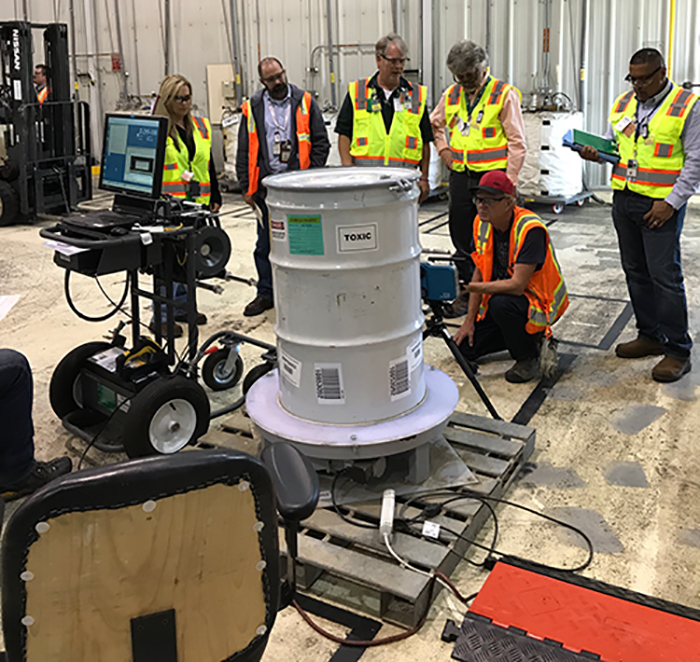 Fluor Idaho deployed a system to characterize the contents of some containers at the Advanced Mixed Waste Treatment Project by measuring their dimensions and entering them into a computer program. It allowed personnel to characterize hundreds of waste containers that otherwise couldn’t be characterized with traditional equipment due to the shape or configuration of the waste.
IDAHO FALLS, Idaho – Challenging waste types and uniquely shaped waste containers have kept things interesting for employees of the DOE Idaho National Laboratory (INL) Site’s Advanced Mixed Waste Treatment Project (AMWTP).
Those challenges have required the employees to adapt the AMWTP facilities to ultimately dispose the waste and containers.
During the 16-year mission to retrieve, characterize, treat, certify, and ship for disposal 65,000 cubic meters of transuranic and low-level wastes, AMWTP received tens of thousands of 55-gallon drums and boxes in various conditions.
Those elements presented obstacles, such as containers too large to fit into the boxlines for resizing and repackaging. The boxlines are huge concrete and metal hot cells where the containers of radioactive waste are opened and sorted without exposing workers to hazardous materials inside.
Most recently, AMWTP treated waste containing the reactive metal uranium. Operators used robotic arms to dump the waste contents into trays and rake through the material. The waste was repackaged and compacted in the facility’s supercompactor before being safely shipped offsite for permanent disposal.
“It all went according to plan,” said Nate Loftus, project manager with Fluor Idaho, EM’s INL Site cleanup contractor. “We had modified our procedures and put safety processes in place to protect our employees and facilities. This was yet another example of how effective our workforce is at adapting and completing our cleanup mission.”
 Crews resized gloveboxes containing waste and other large debris after opening 12-foot-high waste boxes from laboratories at EM’s former Mound Site in Ohio.
In another recently completed project, crews resized gloveboxes containing waste and other large debris after opening 12-foot-high waste boxes from laboratories at EM’s former Mound Site in Ohio during the Cold War. The challenge of that project was safely dispositioning the waste contaminated with plutonium-238, an extremely fine, dust-like material.
Enclosures with reverse airflow and extensive high-efficiency particulate air filters allowed employees — wearing personal protection equipment and using supplied breathing air — to safely open the boxes and resize the materials. A separate enclosure was erected at the nearby Accelerated Retrieval Project VII facility where workers used tools, such as reciprocating saws, to reduce the size of gloveboxes.
Another success story involved the disposition of 30 boxes containing high-activity isotopes. To prepare for processing this waste, employees developed new procedures, conducted engineering evaluations, drafted new radiation control requirements, and completed additional training.
Crews opened the boxes inside a boxline using a robotic arm, transferring the contents to a metal trough where the waste was separated into smaller, lower-activity amounts. Then they moved the segregated debris through a port into an awaiting drum.
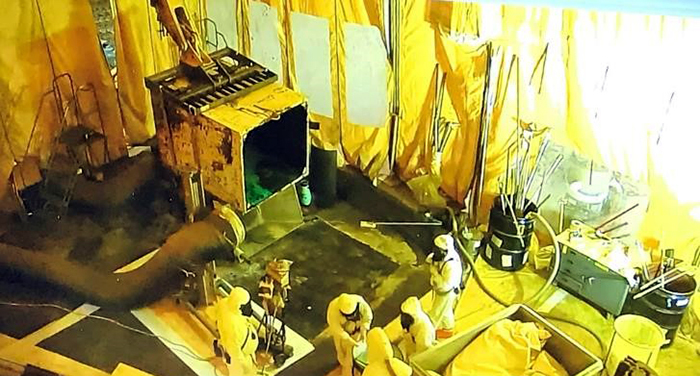 Inner contamination enclosures were in essence soft-sided buildings within a building that allowed crews to open, resize, segregate, and repackage challenging waste forms or containers.
Fluor Idaho also deployed a new system to characterize the contents of some containers by measuring their dimensions and entering them into a computer program. This system was helpful when workers couldn’t obtain valid results due to the shape or configuration of waste in several hundred containers.
For that work, employees also used data from a camera that maps gamma rays emanating from the containers and locates portions with high levels of radiation. The system then characterized the gamma rays and determined specific isotopes and radioactive quantities. The technology also double-checked waste characterization assessments for consistency.
“Putting the system into use allowed us to provide the specific characterization data required by WIPP,” Fluor Idaho Manager Ed Gulbransen said. Waste treated at AMWTP is sent to the New Mexico repository for permanent disposal.
-Contributor: Erik Simpson
Back to Top
IDAHO FALLS, Idaho – Two pieces of equipment at the Advanced Mixed Waste Treatment Project (AMWTP) deliver a proverbial one-two punch to help the facility with the disposition of waste more safely and efficiently.
Crews have used three robotic arms to open radioactive waste containers, reduce the size of concrete and other difficult waste forms, and sort and package the waste in 55-gallon drums for compaction in the supercompactor. They have worked with the robotic arms in boxlines, huge concrete and metal hot cells that protect workers from coming into contact with the waste.
At one point in the waste treatment mission, the workers realized they needed a larger robotic arm attachment than the ones they used.
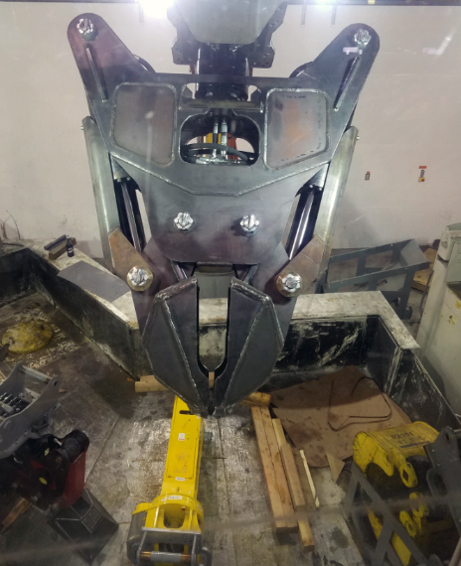 |
|
The "super clam" can crush a drum into the size of a basketball or sheer metal objects into small enough pieces to fit into a 55-gallon silver drum. |
AMWTP engineers partnered with an Idaho Falls, Idaho, firm to fabricate a new arm attachment known as the “super clam.”
The super clam easily reduces the size of waste boxes, drums, concrete, and metal containing transuranic (TRU) constituents. It is so powerful and dexterous that operators can crunch a 55-gallon drum into the size of a basketball, reduce solid concrete slabs into small chunks, and quickly crush waste boxes and metal debris. Operators have become so proficient using the super clam that they can even gently turn the pages of magazines they occasionally find in the waste.
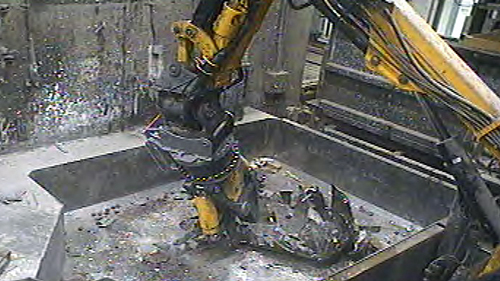 |
|
A robotic arm resizes a metal tank in one of the Advanced Mixed Waste Treatment Project’s boxlines. |
A waste drum awaits the supercompactor's hydraulic ram. |
|
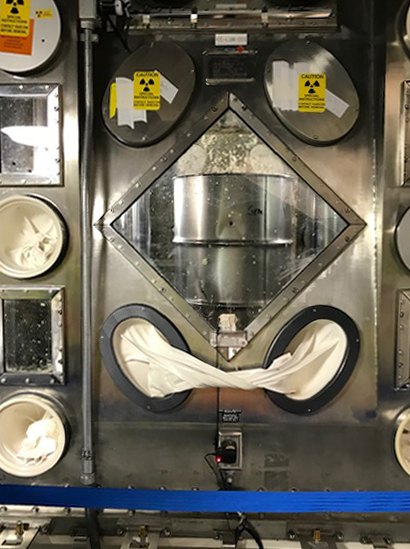 |
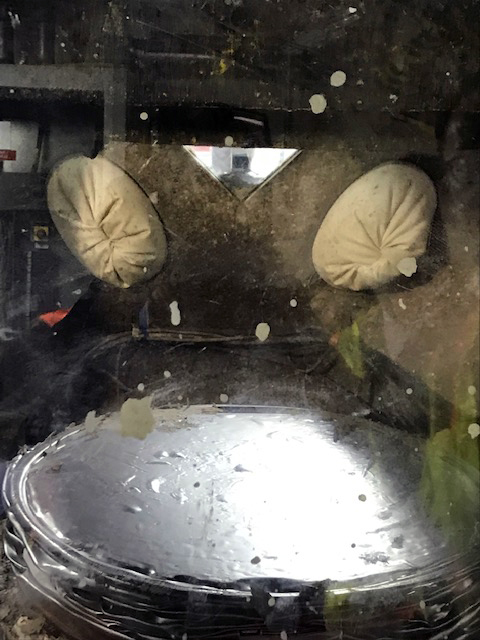 |
|
A silver 55-gallon was crushed into a “puck” by the supercompactor. |
Workers use the robotic arms in concert with AMWTP’s supercompactor, which leverages 4 million pounds of force to reduce a standard 55-gallon drum filled with solid TRU waste debris to a five- to seven-inch-thick puck. Its crushing force is so powerful that it has squeezed several ounces of water out of kiln-dried lumber. Drums of debris that meet AMWTP entry requirements, and contain no prohibited items, go directly to the supercompactor via a conveyer line.
The supercompactor has been among the most popular attractions of the 40-plus tours each year at the Idaho Cleanup Project. Visitors often insist on watching several drum compactions before leaving AMWTP.
-Contributor: Erik Simpson
Back to Top
 Thousands of drums at the Advanced Mixed Waste Treatment Project at DOE's Idaho National Laboratory Site await shipment to EM's Waste Isolation Pilot Plant.
IDAHO FALLS, Idaho – The transuranic (TRU) waste debris treatment mission scheduled to conclude this fall at DOE’s Idaho National Laboratory (INL) Site represents a relatively small footprint within the broader Advanced Mixed Waste Treatment Project (AMWTP).
Although the mission to resize and repackage TRU waste at AMWTP’s Treatment Facility is set to end in coming weeks, workers will continue shipping TRU and low-level waste out of AMWTP for off-site disposal well into the next decade.
“The Treatment Facility will close, but we still have an overall mission to complete,” said Bryan Breffle, a director at Fluor Idaho, EM’s INL Site cleanup contractor. “We’re the largest shipper to the Waste Isolation Pilot Plant (WIPP) and we will continue to be for the foreseeable future.”
In late June, AMWTP completed its 500th shipment to WIPP since the permanent disposal repository in New Mexico reopened and resumed receiving waste in April 2017. Those 500 shipments comprised 11,300 drums of waste.
 Advanced Mixed Waste Treatment Project crews prepare a transportation cask containing waste for shipment to EM's Waste Isolation Pilot Plant.
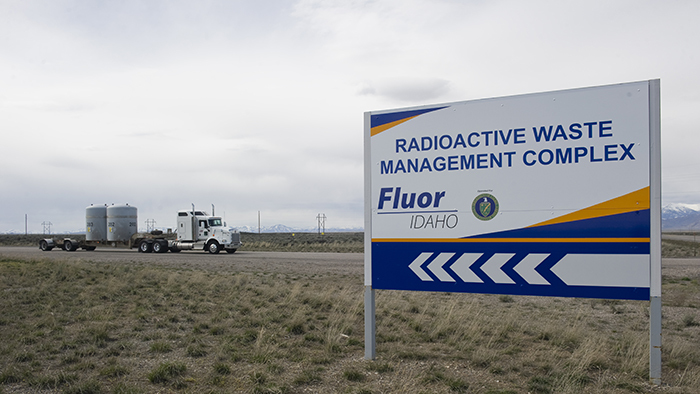 Shipping waste from the Advanced Mixed Waste Treatment Project to the Waste Isolation Pilot Plant is set to continue for the next decade.
As many as seven TRU waste shipments leave the INL Site for WIPP every week. EM’s INL Site program is responsible for nearly 60 percent of the shipments WIPP has received. Transportation casks containing TRU waste are a common sight at AMWTP, staged for use on the plant’s north side.
AMWTP has sent more than 6,300 shipments of TRU waste to WIPP, representing nearly 9 million miles of shipments.
“Our track record of sending waste to WIPP is outstanding,” said Breffle. “The public and communities along the way should feel assured that we have an impeccable safety record and we’ll continue to build on it as we move forward.”
The Idaho State Police is responsible for thoroughly inspecting each shipment before it can enter Idaho’s roadways en route to WIPP. A burned-out turn indicator bulb on a truck or tractor trailer is enough to delay a shipment until a replacement is installed.
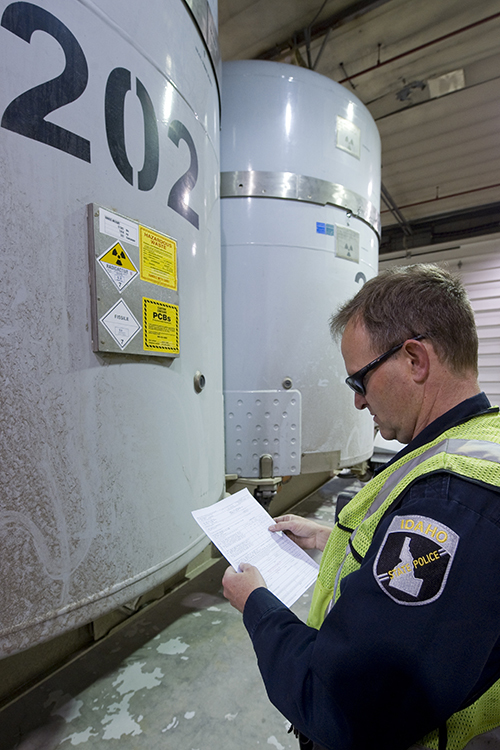 |
|
Each shipment to EM's Waste Isolation Pilot Plant must be cleared for travel by an Idaho State Police trooper following a thorough inspection. |
“We have a great appreciation for the Idaho State Police,” Breffle said. “They leave no stone unturned in their inspection. It’s all about keeping the driver and public safe.”
Additional TRU and low-level waste generated from a targeted waste exhumation effort at the INL Site’s Accelerated Retrieval Project will also be prepared for shipment out of the state by AMWTP crews.
EM waste shipments will continue to leave the INL Site for up to 10 years.
-Contributor: Erik Simpson
Back to Top
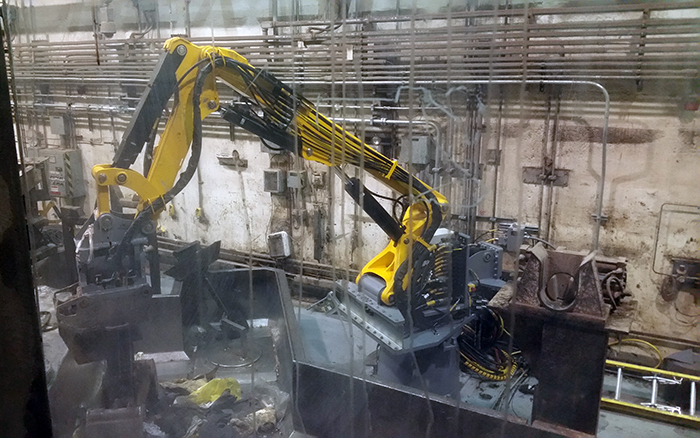 A new robotic arm was installed at the Advanced Mixed Waste Treatment Project to provide more “muscle” in waste resizing operations.
IDAHO FALLS, Idaho – Following its eventual closure, the Advanced Mixed Waste Treatment Project (AMWTP) will leave behind a legacy of being a successful waste treatment facility that was well conceived, built, and executed.
Construction of the plant began in the late 1990s, and crews safely finished building it in late December 2002, three days ahead of the completion date required under the 1995 Idaho Settlement Agreement. AMWTP went on to meet several additional milestones under the agreement with the state of Idaho.
Safety has been a hallmark of the project, as the plant’s workers surpassed more than 16 million hours without a lost-time injury. They are nearing completion in the mission to retrieve, characterize, treat, certify, and ship for disposal 65,000 cubic meters of transuranic and low-level waste that had been stored on an asphalt pad at DOE’s Idaho National Laboratory (INL) Site since 1970.
Some of that waste presented unique challenges, such as the large size of containers, the high concentrations of radionuclides, and the potentially reactive properties of the materials. Crews have safely treated all of that challenging waste in recent years.
In each case of challenging waste forms, AMWTP employees developed technologies, processes, and worker-protection measures to safely and compliantly treat the waste.
“AMWTP workers continually developed new technologies to address challenges at the project,” EM Idaho Manager Jack Zimmerman said. “Many of these technologies have been deployed at other DOE facilities across the complex. Thus, in some instances, AMWTP workers have been able to solve a complex-wide problem.”
For example, the radiological protection, safety, and engineering divisions at Fluor Idaho, EM’s INL Site cleanup contractor, collaborated with a vendor to improve supplied breathing-air suits, also known as "bubble suits." They made those suits safer by adding reinforcements, and cooler by improving their air flow.
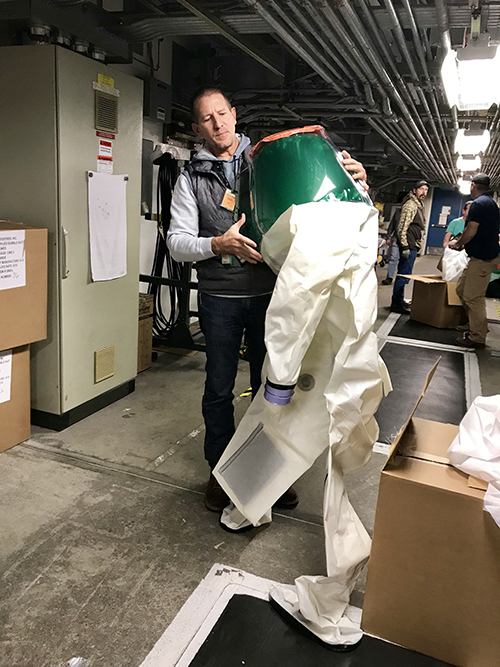 |
|
Former Advanced Mixed Waste Treatment Project (AMWTP) employee Chad Jardine holds a "bubble suit," a critical piece of personal protective equipment for workers who conduct maintenance in AMWTP’s boxlines. |
“If there’s one takeaway from the 16-plus years of active operating experience at the AMWTP that others could benefit from, it’s the need to be adaptable, to expect the unexpected, and work with employees to mitigate challenges,” Fluor Idaho President Fred Hughes said. “Being flexible, implementing employee ideas, and modifying processes and equipment, when necessary, made the difference down the stretch.”
In another example, employees at the AMWTP Treatment Facility added a new, more powerful robotic arm than the older one they had used to open waste containers, reduce the size of difficult waste forms, and sort and package the waste in 55-gallon drums for compaction in the supercompactor.
“Other DOE facilities that will require the construction of a similar waste treatment facility should examine the conception-to-closure history of the AMWTP,” Hughes said. “It was the experienced talent of the workforce and their innovations that were required to treat all wastes regardless of their complexity.”
-Contributor: Erik Simpson
Back to Top
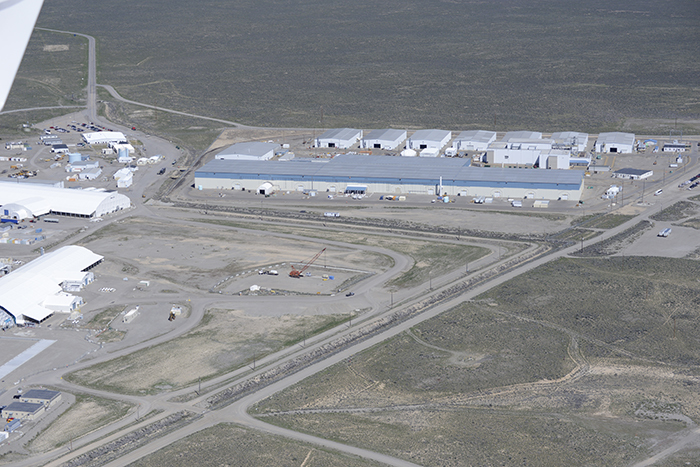 Under a proposed strategy, the Transuranic Storage Area/Retrieval Enclosure, which is the large gray building pictured here, would become the first building to be closed at the Advanced Mixed Waste Treatment Project at DOE's Idaho National Laboratory Site.
IDAHO FALLS, Idaho – The ultimate closure of the Advanced Mixed Waste Treatment Project (AMWTP) will involve a coordinated effort among the state of Idaho, EM, the DOE Idaho Operations Office, and cleanup contractor Fluor Idaho.
Planning is underway to close the waste treatment facility under the federal Resource Conservation and Recovery Act. The project includes a systematic and integrated building demolition effort.
Challenges will result from the need to complete the work in phases. AMWTP’s closure is dependent on two other projects: completion of the targeted transuranic (TRU) waste retrieval mission of the Accelerated Retrieval Project (ARP) and the site preparation and construction of a gravel and soil cover to place over the 97-acre Subsurface Disposal Area and the western portion of AMWTP.
Under a proposed strategy, the five-acre Transuranic Storage Area/Retrieval Enclosure (TSA/RE) at AMWTP would be removed first to make way for part of the earthen cover and an extensive water drainage system off the landfill cover.
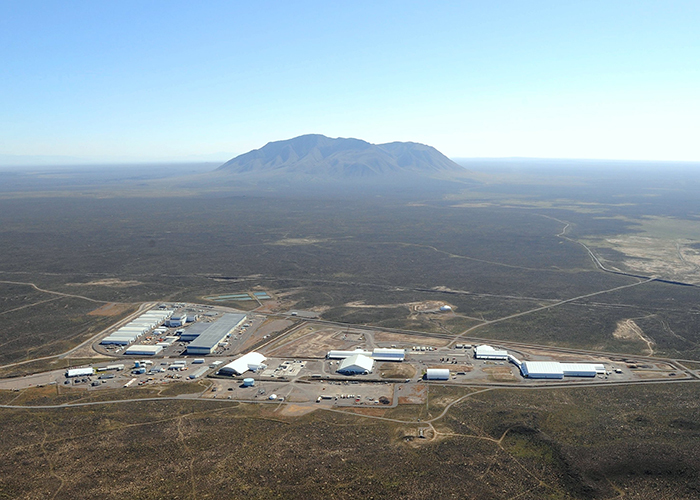 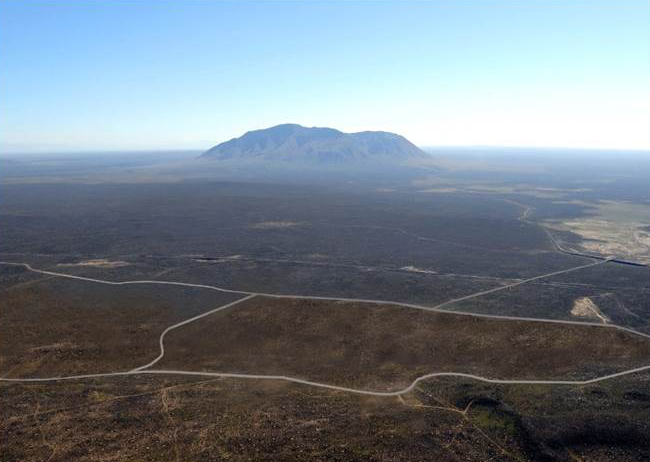 At top is a view of the Radioactive Waste Management Complex at DOE's Idaho National Laboratory Site. Ultimately, an earthen cover will be built over the site as shown in the rendering immediately above.
In the second phase, the AMWTP Treatment Facility and associated buildings are set to be closed. EM is scheduled to complete its TRU waste debris treatment mission at the Treatment Facility this fall. That’s where robotic arms resize waste and a supercompactor crushes 55-gallon drums as part of volume-reduction and treatment efforts.
The third phase involves closing remaining AMWTP buildings once all TRU and low-level waste is shipped for disposal. Shipments to EM’s Waste Isolation Pilot Plant are scheduled to continue up until 2028.
Meanwhile, the buried TRU exhumation project at ARP IX is projected to be completed late next year. Demolition of that facility and remaining soft-sided buildings from previous targeted buried waste exhumation projects will commence soon after.
Ultimately, a 10-foot-thick earthen cover spanning more than 150 acres will be built over the landfill, and a drainage system will be constructed to move water away from it.
-Contributor: Erik Simpson
Back to Top
|